
Rediscovering Japan

Rediscovering Japan
Travel (Eastern Tokyo (Ryougoku/Kameido/Kiyosumi-shirakawa))

by tomizuta
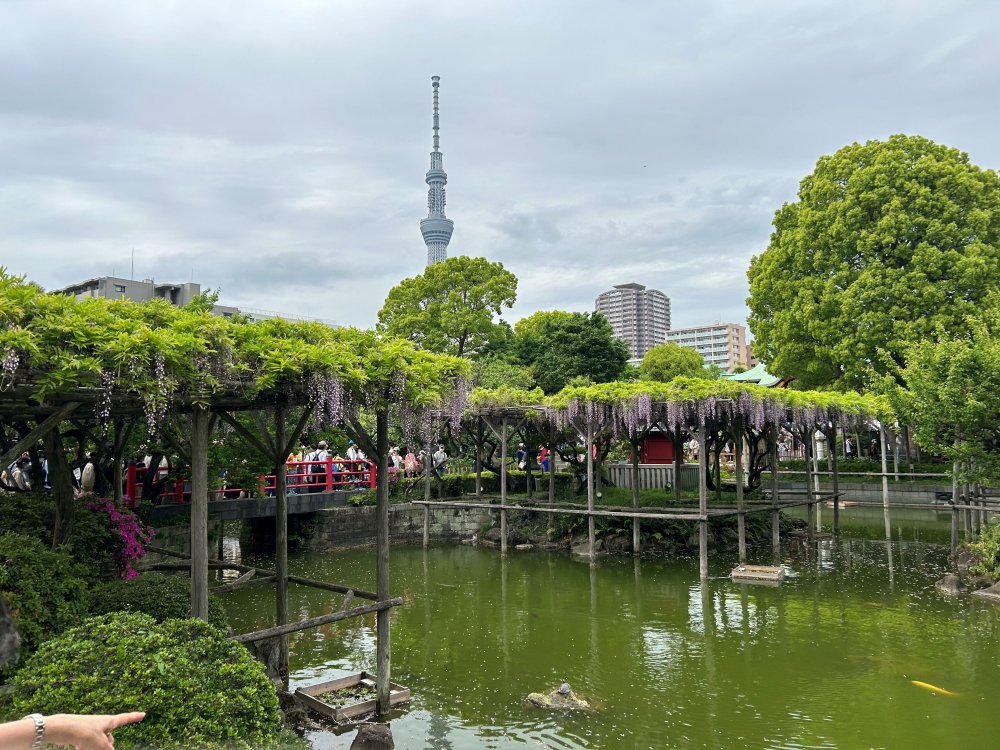
The beautiful wisteria garden of Kameido Tenjin. It is a popular place to visit especially during the flowering period of the wisteria from late April to May. I took this photo in late April 2024, during their Wisteria Festival. The wisteria in 2024 was not that spectacular perhaps owing to the irregular weather (warm spells and cold spells).
In June 2019, we made a day excursion to the eastern peripheral of old Edo. Come to think of it, I had never seriously studied where the eastern boundary was. To some extent it overlaps with the image of “shitamachi.” Loosely, Edo was divided into two areas “yamanote” on the western side of Edo Castle and “shitamachi” on the eastern side. The name “yamanote” remains in the JR Yamanote Line, but the “yamanote” of old Edo was much smaller. The northern peripheral up to Otsuka Station is the same, but from Ikebukuro to Osaki on the west and south was out of the boundary of Edo. A rough image of “yamanote” would be anti-clockwise, Hongou, Koishikawa, Ushigome, Yotsuya, Akasaka, Azabu and Shiba. Large feudal lords’ mansions, samurai residences and Buddhist temples were situated in the “yamanote” area. On the other hand, “shitamachi” was composed of areas including Kyobashi, Nihonbashi, Kanda, Ueno, Asakusa, Honjo and Fukagawa, which was predominantly the merchant and craftsmen area but many feudal lords’ mansions, samurai residences and Buddhist temples also existed in these areas as we will see below. There are many visitors to Ginza and Asakusa and to the Edo Museum in Ryougoku where we have visited so many times. But on this occasion, we wanted to visit some other places in “shitamachi” that we had never been before. Our first destination was the former Yasuda Residence Gardens which is situated a couple of minutes’ walk north of JR Ryougoku Station.

The south entrance to former Yasuda Residence Gardens.
In the Edo era, there were quite a few residences of feudal lords on the eastern banks of Sumida River. The former Yasuda Garden was the shimoyashiki (lower residence) of the Honjou-Matsudaira Family who was the feudal lord of Kasama feudal domain in Ibaraki Prefecture but eventually reassigned to Miyazu in Kyoto Prefecture which continued to the end of the Edo era. It was customary for feudal lords to maintain multiple residences called kamiyashiki, nakayashiki and shimoyashiki. Typically, kamiyashiki (upper residence) was located in the yamanote area closer to Edo Castle which was the main residence of the feudal lords in Edo. Feudal lords had to live in Edo every other year and the wife and heir had to always live in Edo. Shimoyashiki was a residence where the feudal lord could relax and often had a grand garden. After the collapse of the Tokugawa shogunate in 1868, there was no need for the former feudal lords to maintain their residences in Tokyo, which were purchased by the Meiji Government and wealthy individuals. The shimoyashiki was acquired by Zenjirou Yasuda in 1891. Zenjirou, the founder of the Yasuda conglomerate, was a banker. He had already in 1879 bought another neighboring prominent residence of the Tayasu Tokugawa Family, which he used to entertain guests. The former Yasuda Garden became Zenjirou’s main residence. Zenjirou was a philanthropist and in his will, bequeathed his main residence to the municipal government of Tokyo in 1922. It has been a public park since 1927. The other property area to the north of Yasuda Garden has now been converted to a hospital and a junior high/high school bearing the name Yasuda College. We entered through the south gate.
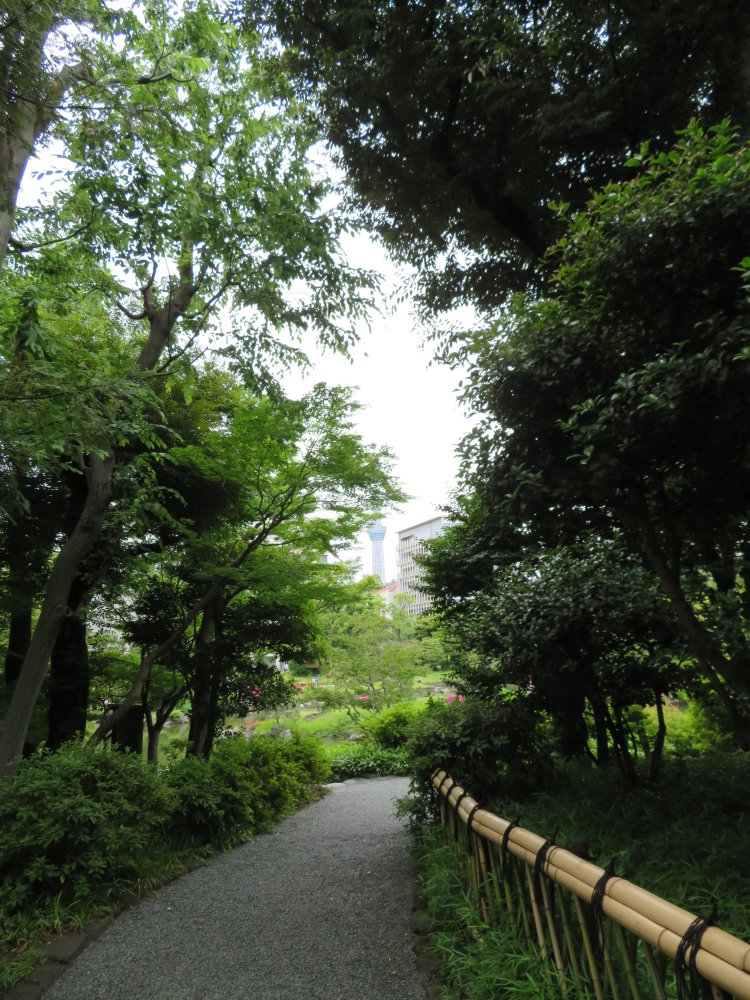
From the south gate, we went in towards the pond.
A short walk brought us to the pond. This pond is called Shinji-ike, meaning pond in the shape of the kanji character for “heart(shin).” Tokyo Sky Tree can be seen in the north. Formerly, a historical dome shaped building, Ryougoku Public Hall stood on the north of the pond, but this was demolished and replaced by the modern Japanese Sword Museum in 2018.
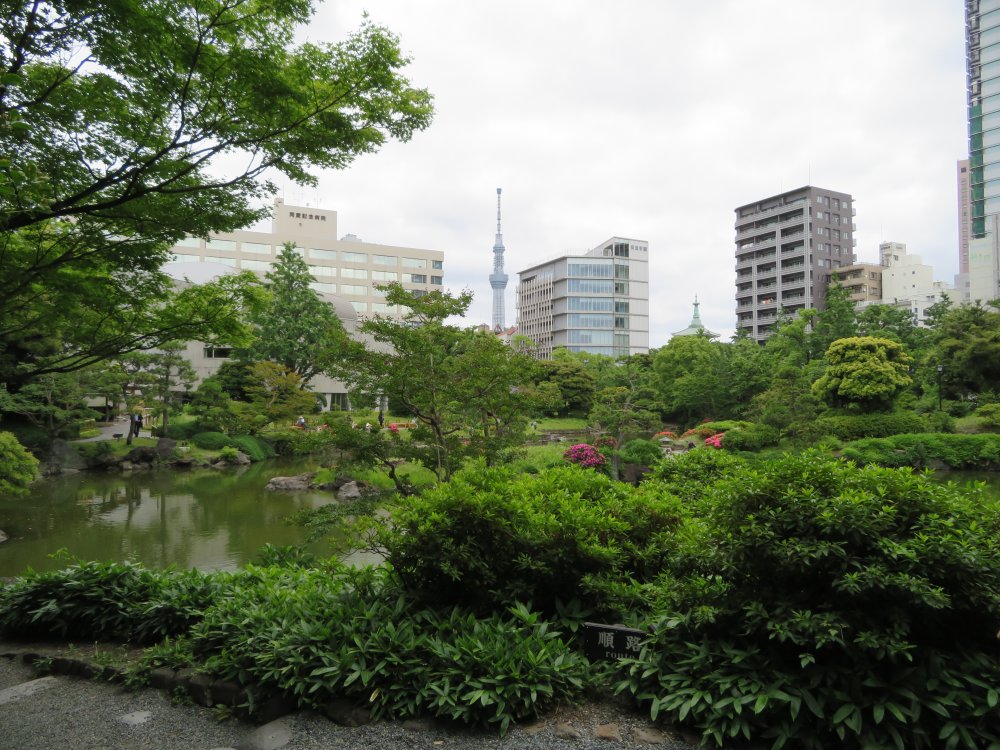
Formerly, a historical dome shaped building, Ryougoku Public Hall stood on the north of the pond, but this was demolished and replaced by the modern Japanese Sword Museum in 2018. Tokyo Sky Tree can be seen in the north.
On the eastern edge of the garden, there was a boulder and an inari shrine in front. The description beside the boulder tells “In 1631, there was a severe flooding of Sumida River caused by an autumn typhoon. A brave samurai responded to Shougun Iemitsu’s order to inspect the state of the eastern bank side which was worst affected. He bravely crossed the river on horseback and rested his horse by the boulder. Komadome Inari shrine was built by the local people in remembrance of their gratitude to him.”
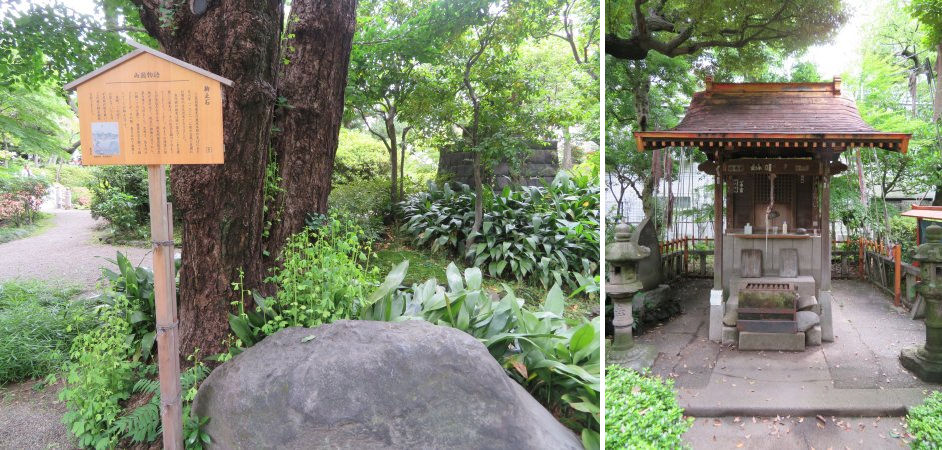
The boulder where the brave samurai rested his horse (left) and Komadome Inari shrine sitting opposite the boulder (right).
The view from the northern bank was equally stunning. It was a week day morning, but there were quite a few visitors to the garden, many taking pictures. I would certainly recommend a visit when you are in the Ryougoku area to watch the sumo bout at the Kokugikan or visiting the Edo Tokyo History Museum.
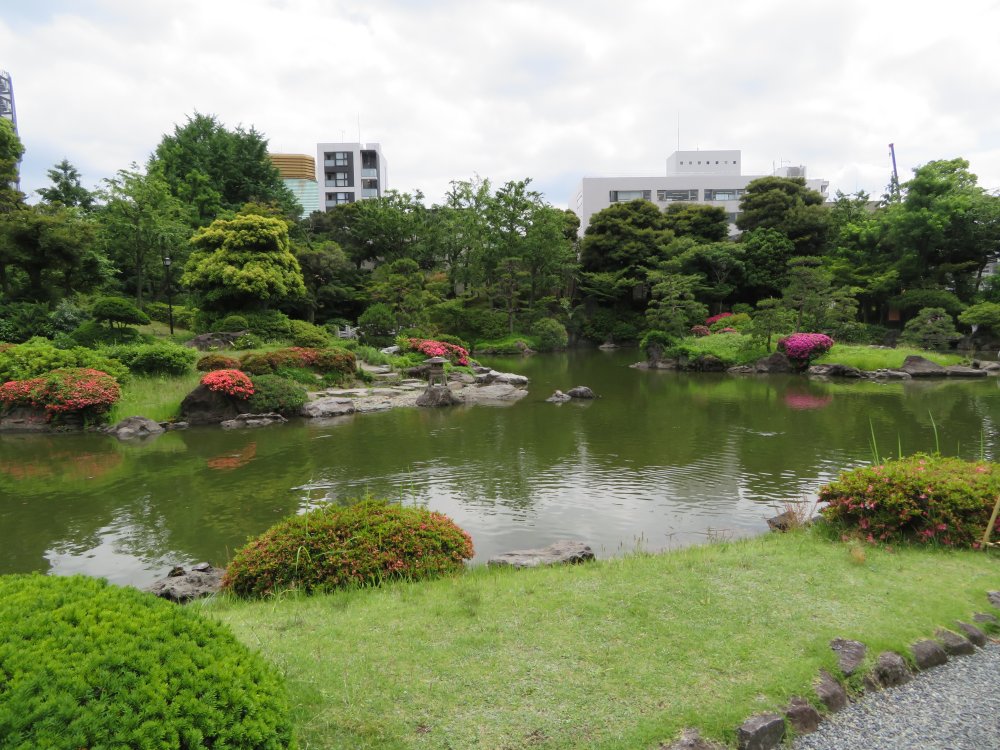
The view from the northern bank was equally stunning.
Across the road from the northern entrance of Yasuda Garden is Yokoamichou
Municipal Park. The site was formerly a military uniform factory acquired
by Tokyo in 1922 upon the relocation of the factory, to open as a municipal
park. But before the opening of the park, the Great Kantou Earthquake struck
Tokyo on September 1st, 1923. Not only did the earthquake cause the total
collapse of more than a hundred thousand houses, but as the earthquake
hit at noon when many were cooking lunch over fire, fire broke out and
combined with the strong wind from a typhoon, more than a hundred major
fires broke out covering 50% of Tokyo. Fire raged particularly in the shitamachi
area. Forty thousand people sought refuge in the vacant park site of which
thirty eight thousand lost their lives in a horrific whirlwind fire. The
Tokyo Memorial Hall was built in 1930 to mourn for the people that lost
their lives in the Great Kantou Earthquake. In 1948, the people that were
killed in the Tokyo bombing of March, 1945 are also remembered in the Hall.
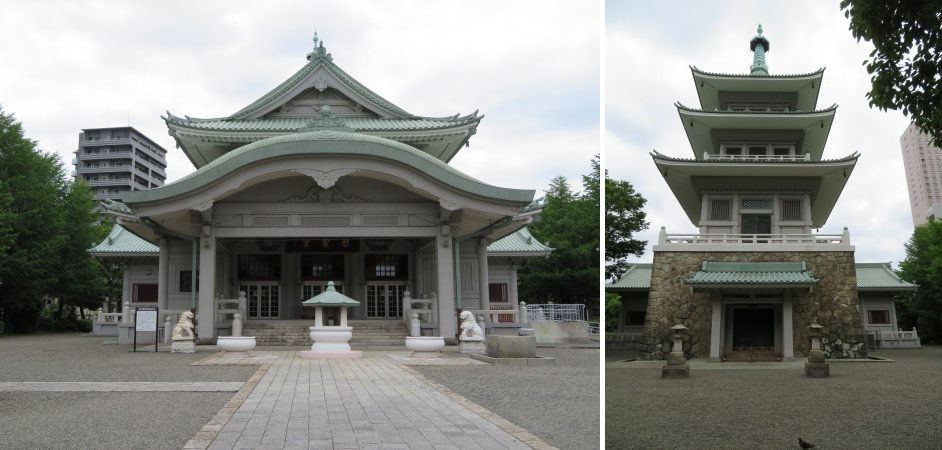
The Tokyo Memorial Hall built in 1930 (left) and the three story pagoda in the rear of the Hall (right).
There is another building built in 1931 to remember the recovery efforts from the Great earthquake. The Recovery Museum is open to the public and displays many pictures and salvaged items from the Great Kanto Earthquake and fire as well as those related to war-damaged Tokyo during WWII. There is no admission fee.
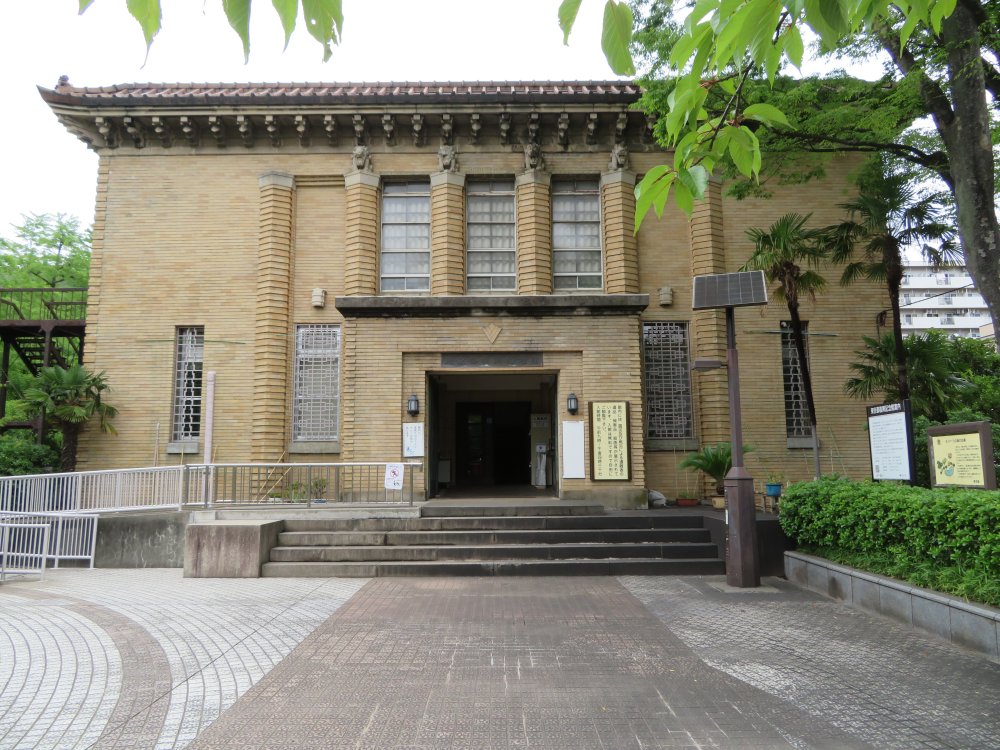
The Recovery Museum built in 1931 to remember the recovery efforts from the Great earthquake.
We next walked back south past JR Ryougoku Station to Ekouin Buddhist Temple of the Joudo sect. Fires were frequent in Edo because of the crammed wooden buildings. There was a large fire in 1657, where sixty percent of Edo went into flames and more than a hundred thousand lost their lives most of whom were unidentified. Shougun Ietsuna held a large Buddhist service to bury and pray for the deceased. Ekouin was founded on this site. Since then the temple continued to bury victims of natural disasters, those without relatives and executed criminals without discrimination. The temple also buries and prays for cats, dogs, military horses and other animals. Ekouin also used to host sumo tournaments on this site. The first bout took place in 1768, and from 1833 a semi-annual regular tournament was held until 1909 when the first Ryougoku Kokugikan (National Sports Hall) was built on the temple premises. A monument stands by the main entrance gate to Ekouin.
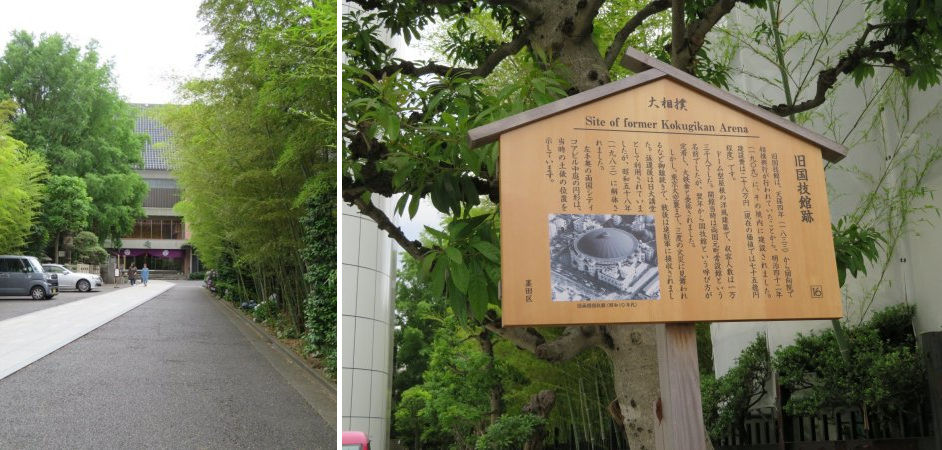
The entrance to Ekouin (right). The entrance gate was scaffolded for repair. A description of the site of the first Kokugikan by Ekouin's entrance gate (right) You can see the acaffolded gate on the right.
In the temple grounds, there are many monuments and graves to observe. First, there is the Chikarazuka. This is a monument erected by Japan Sumo Association (JSA) in 1936 in remembrance of the toshiyoris or more commonly oyakatas of the JSA. Toshiyori is a job position in the association that takes care of a sumo stable. Currently, there are more than forty such stables.
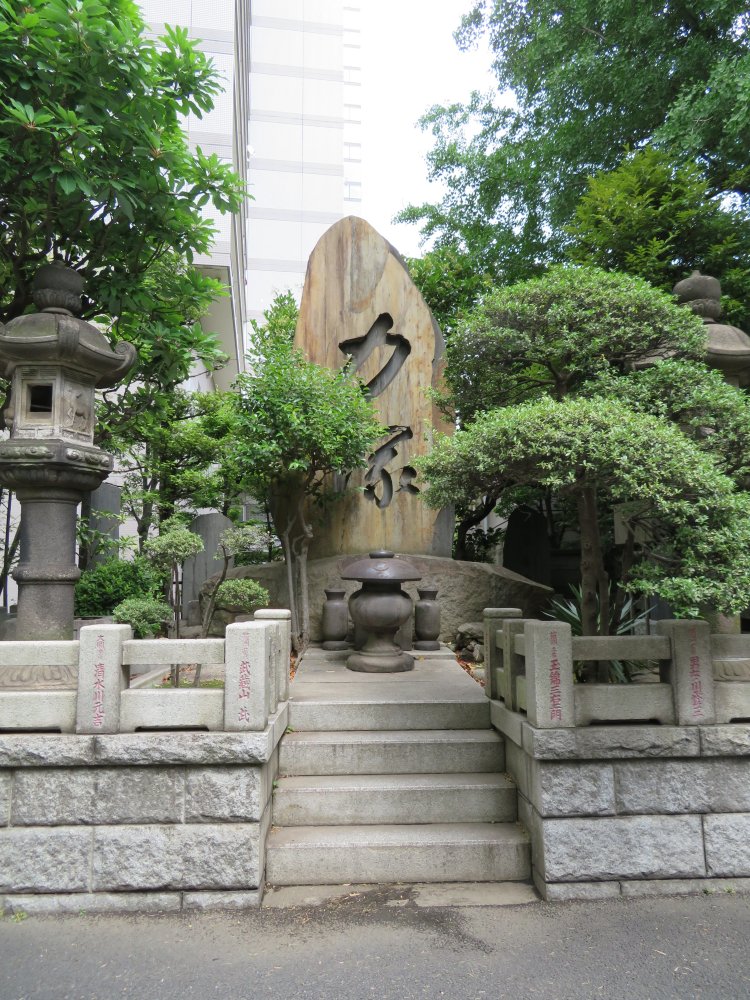
Chikarazuka, a monument erected by Japan Sumo Association (JSA) in 1936 in remembrance of the toshiyoris or more commonly oyakatas of the JSA.
Amidst the various monuments related to natural and maritime disasters, there is a relatively new monument built in 2002 with a statue of the benevolent Kanzeon-bosatsu to pray for all creatures. The statue is introduced in the opening page of Ekouin’s website, titled “the temple that, through history was always by the side of common folk.”
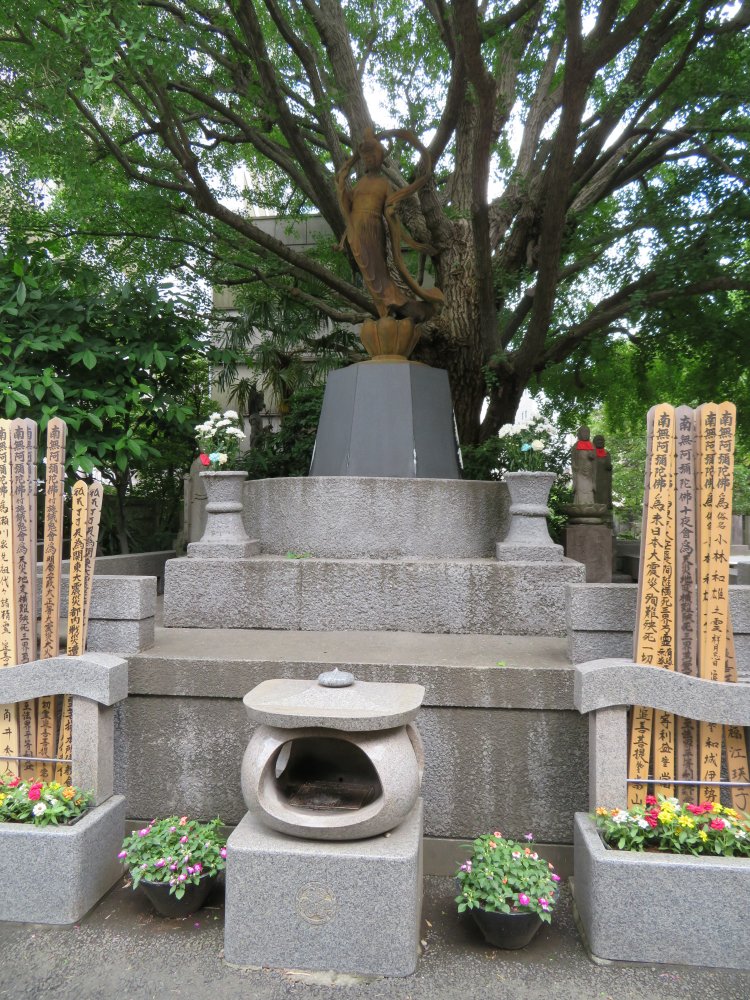
The relatively new monument built in 2002 with a statue of the benevolent Kanzeon-bosatsu to pray for all creatures.
I was interested to learn that Ekouin houses some graves of prominent people from the Edo era including Gidayuu Takemoto (1651-1714), the founder of the Gidayuu style of chanted narration of the puppet theater “jouruli,” one of the three Japanese classic theaters alongside Noh and Kabuki. Another grave that attracts many visitors is that of Nezumi Kozou Jiroukichi (1797-1832). He was a thief and specialized in breaking into the residences of high-ranking feudal lords. He was given the name Nezumi Kozou (small mouse man) for his many break-ins and escapes. After his execution he gained an image similar to Robin Hood, robbing the rich and giving to the poor, and became a popular character in Japanese novels and Kabuki. Because he was a famous escapist, many come to his grave to pray for good luck.
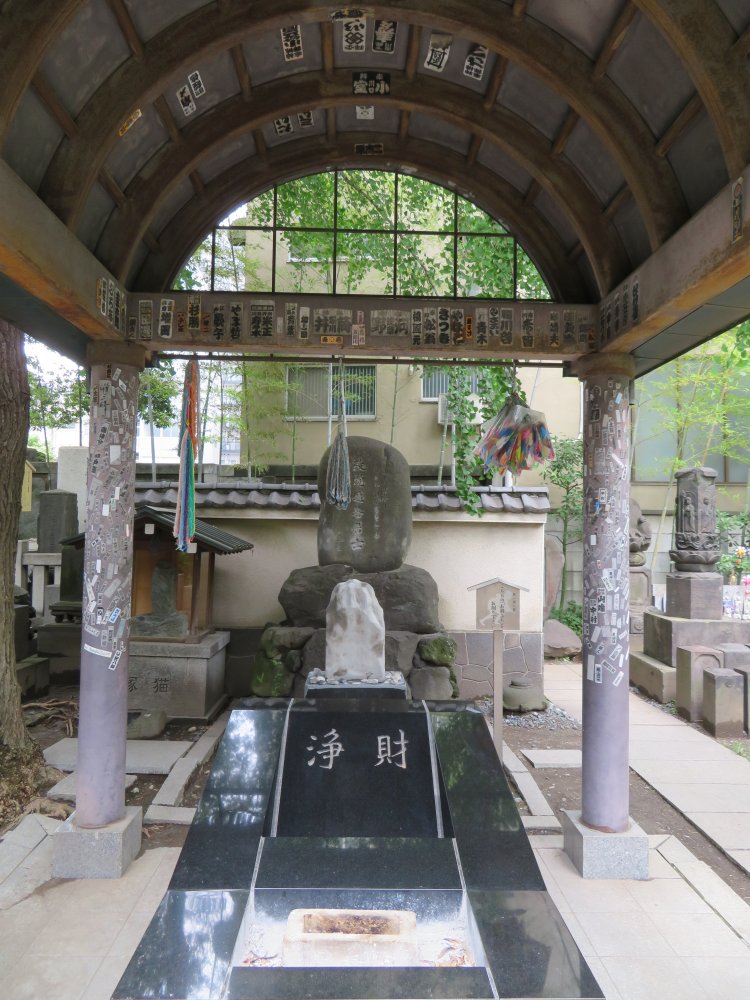
Many come to Nezumi Kozou Jiroukichi's grave to pray for good luck. You are requested to touch the white rock in front of the grave instead of the tombstone itself
Following Ekouin we walked east for a couple of minutes to Honjo Matuzakachou Municipal Park, which was the site of the Edo residence of a high-ranking samurai Yoshihisa Kira (Kouzukenosuke), who became the target of the revenge of forty-seven samurais from Akou (Hyogo Prefecture) which took place on this site in 1701. The attack was to avenge the death of their feudal lord Naganori Asano (Takuminokami), who had been sentenced to death by hara-kiri suicide for attacking Kouzukenosuke in Edo Castle. The saga became a popular theme for Kabuki and novels, usually portraying Kouzukenosuke as a crafty villain and the forty-seven samurais as loyal and heroic subjects. Although it is named a park, it is actually a very small plot surrounded by Edo era style samurai residence walls, with a statue of Kouzukenosuke and a small Shintou shrine. I understand from the pamphlet I obtained in the park, that this shrine called Matuzaka Inari, was set here combining two inari shrines in 1935, Ueno (or Kouzuke) Inari and Kaneharu Inari. The former was here from ancient times and the latter was brought from nearby to most likely pray for the purification of the site after the assassination by the forty-seven samurais.
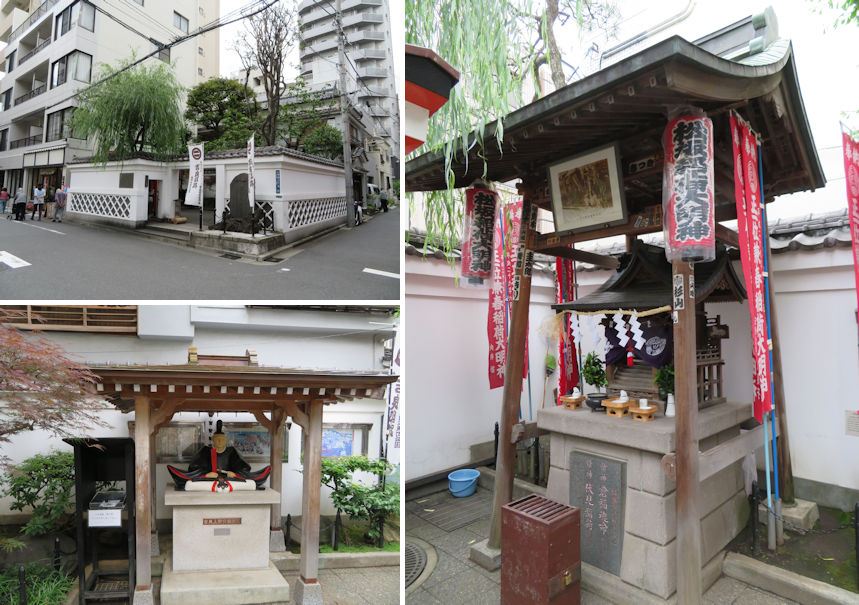
Although a municipal park, it's a tiny block walled with samurai residence walls (upper left) and housing a statue of Kouzukenosuke (lower left) and Matuzaka Inari (right).
We then went back to Ryougoku Station and took the JR Soubu Line east for two stations to Kameido. Since Kameido was included in Fukagawa Ward out of the fifteen wards of Tokyo in the Meiji era, I believe Kameido was the eastern peripheral of old Edo. We wanted to visit Kameido Tenjin Shinto shrine, which we had passed by so many times but never visited before. All I knew was that it is a popular place to visit in April to May, when the wisteria are in full bloom, and that it was the subject of many ukiyoes. It is about a fifteen minutes’ walk north west from JR Kameido Station to Kameido Tenjin. Walking north and then east on Kuramaebashi Street, still quite a few old merchant shops remain to this day, including restaurants specializing in a local dish Fukagawameshi, which is a rice dish cooked with clams and dashi soup stock. We came to the entrance gate facing Kuramaebashi Street. It appeared that the shrine was much grander than I had expected.
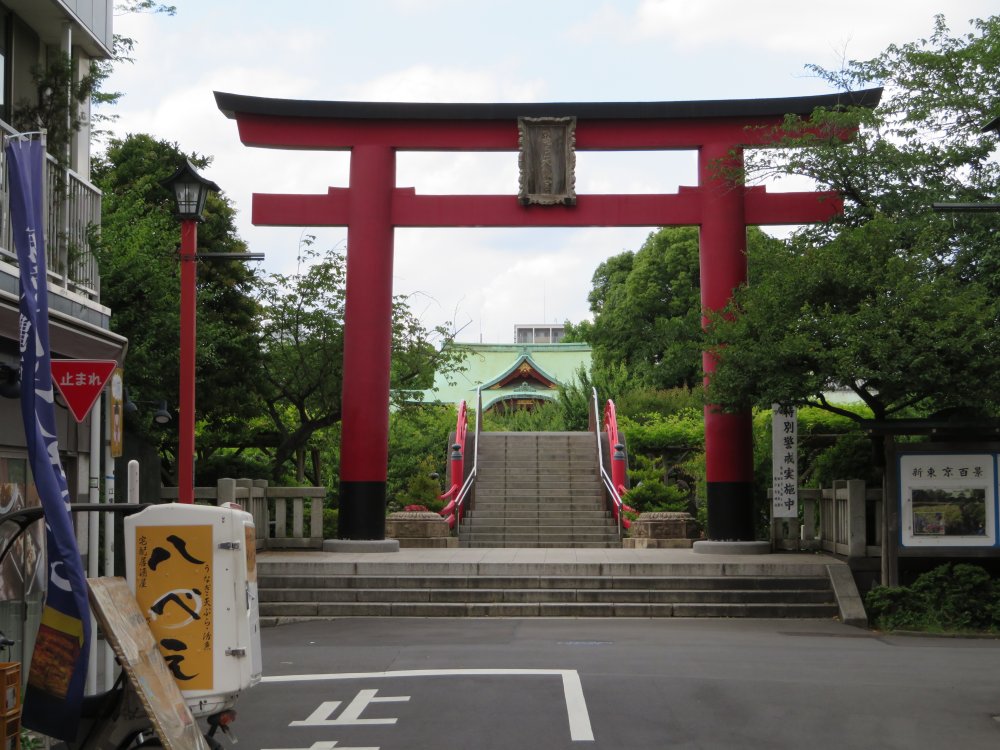
The entrance torii gate to Kameido Tenjin. It appeared that the shrine was much grander than I had expected.
We took a moment to inspect the description by the entrance area. Tenjin originally meant the God of Thunder. But afterwards it came to mean Michizane Sugawara, a learned scholar from the 9th to 10th century. People came to pray at Tenjin shrines to pass examination tests and other academic success. The first and most prominent Tenjin shrine is in Dazaifu Tenmanguu Shintou shrine in Fukuoka. From Fukuoka, Tenjin shrines spread to all over Japan. For example, to Kyoto, where there is Kitano Tenmanguu in Kyoto City. The description tells that a priest from Dazaifu Tenmanguu carved a statue of Michizane from plum wood and dedicated it to Michizane on this site in 1662 which is how this shrine originated. It became a place for Edo folk to pray for academic success as well as to enjoy the plum and wisteria flowers. We went through the center approach to the main shrine building. The flowering period of the wisteria was over but it wasn’t hard to imagine how beautiful it must be in season with the collaboration of the flowers and the pond. Tokyo Sky Tree appeared in the back scenery again.
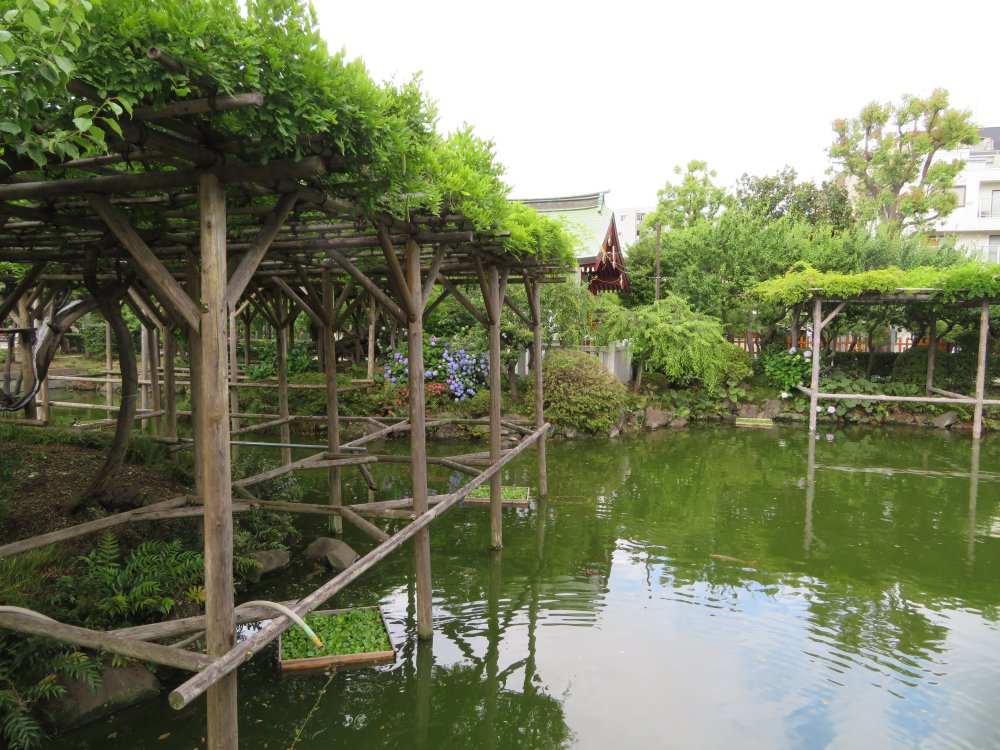
We went through the center approach to the main shrine building. The flowering period of the wisteria was over but it wasn’t hard to imagine how beautiful it must be in season with the collaboration of the flowers and the Shinji-ike pond.
There are three bridges on the center approach. The website of the shrine tells that the first arch bridge relates to the past, the second flat bridge to the present and the third arch bridge to the future. One should purify one's thoughts as you cross the three bridges to prepare for the visit to the main shrine. We spent some time on the grounds in front of the main shrine building. On our way back taking the eastern path, we noticed quite a few plum trees of various species.
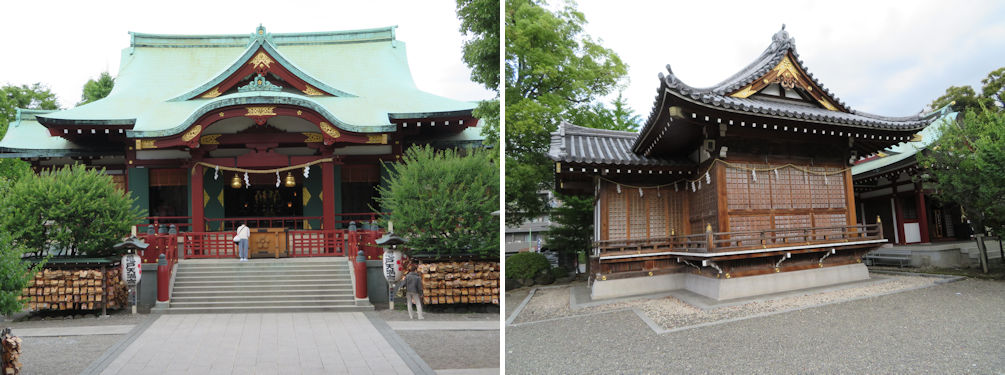
The main shrine building (left) and the Kagura Theatre building further right (right).
(We revisited Kameido Tenjin in late April 2024, during their Wisteria Festival. The wisteria in 2024 was not that spectacular perhaps owing to the irregular weather (warm spells and cold spells). There were many visitors including non-Japanese tourists, as well as numerous food stalls (a familiar sight during shrine and temple festivals).
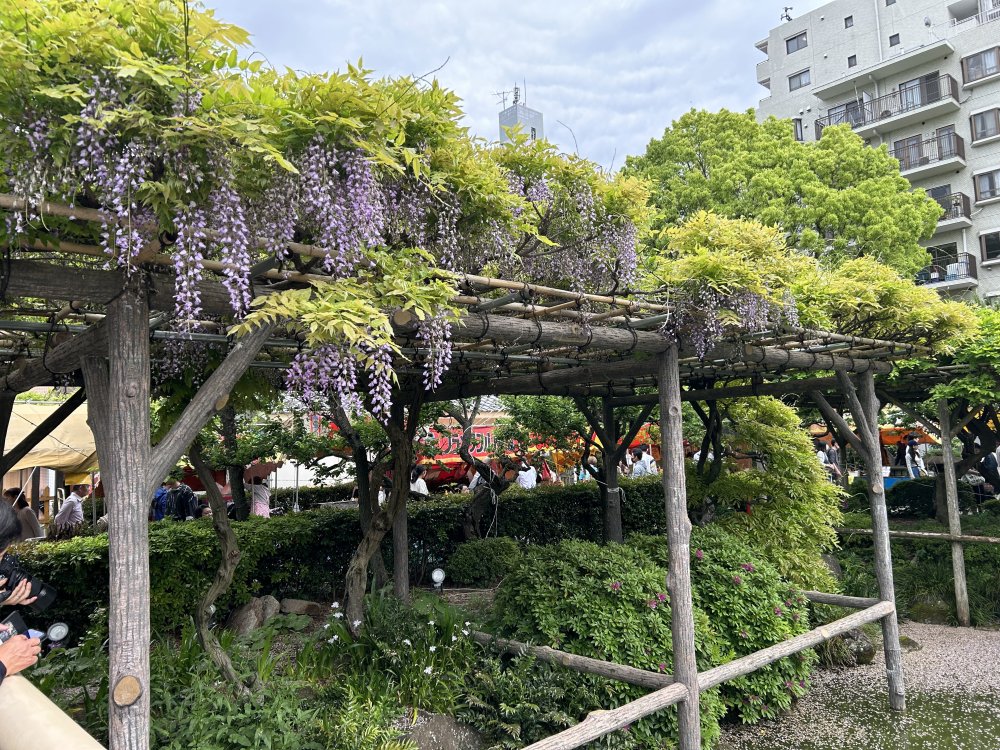
There were many visitors including non-Japanese tourists, as well as numerous food stalls (a familiar sight during shrine and temple festivals).
We left Kameido Tenjin to visit Katori Jinja Shintou shrine close by , on our way back to Kameido Station. I understand that this shrine is much older than Kameido Tenjin. It was invited here by the local people as their protector as a division of the prominent Katori Jinguu Shintou shrine in Katori City, Chiba Prefecture. The main deity worshipped here is the God Futsunushinoookami is a warrior God, hence many athletes visit this shrine to wish for success in sports.
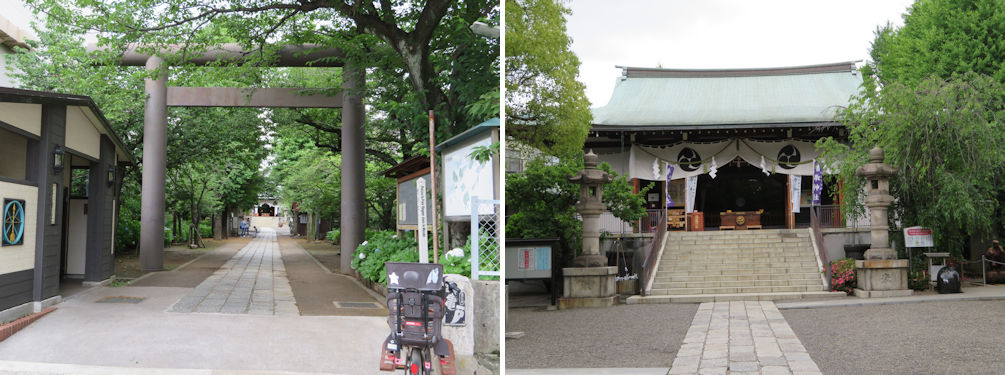
The entrance gate (left) and main shrine (right) of Katori Jinja Shintou shrine.
The shrine is surrounded by tall trees, giving it an ancient and sacred feel fitting for a Shintou shrine. There are some interesting buildings and monuments on the site. One monument that fascinated me was related to a locally grown radish. A description told us that it is a rare species sown in Autumn and harvested in early spring when there are very few vegetables.
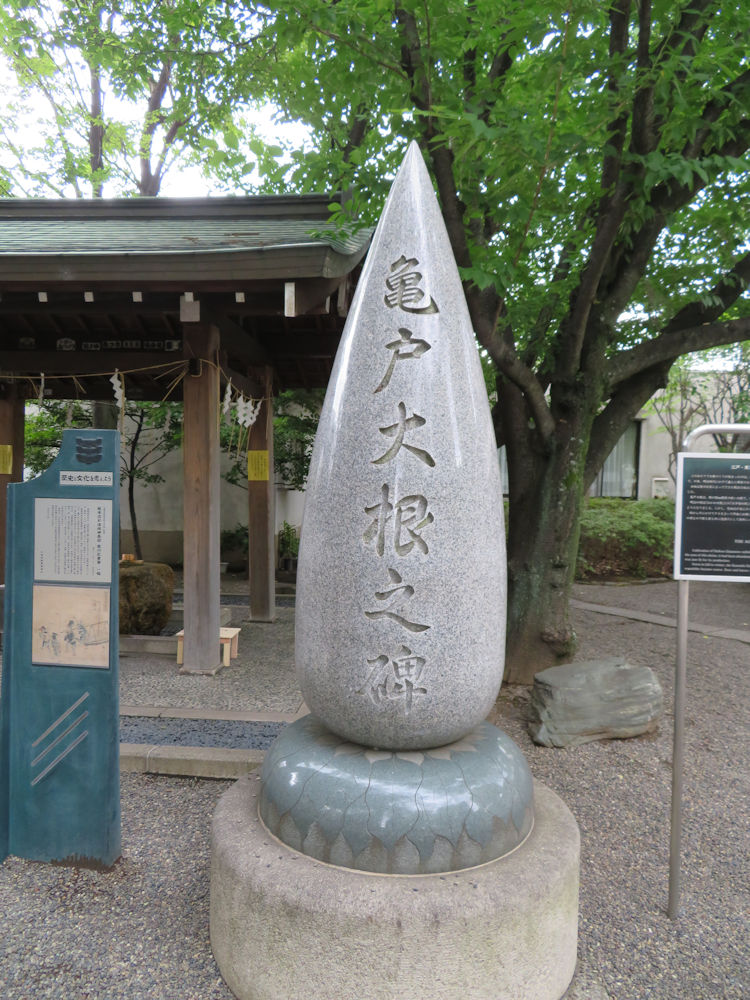
One monument that fascinated me was related to a locally grown radish.
Further closer to Kameido Station, is an area called Kameido Umeyashiki. It is a row of buildings tucked in a corner, with gift shops selling Edo Kiriko glass among other Edo craft and a comedy hall. Just next to Umeyashiki is a restaurant specializing in local food. Luckily, we were able to view Kameido radish that we had just learned of. It was a very satisfying day excursion of eastern Tokyo.
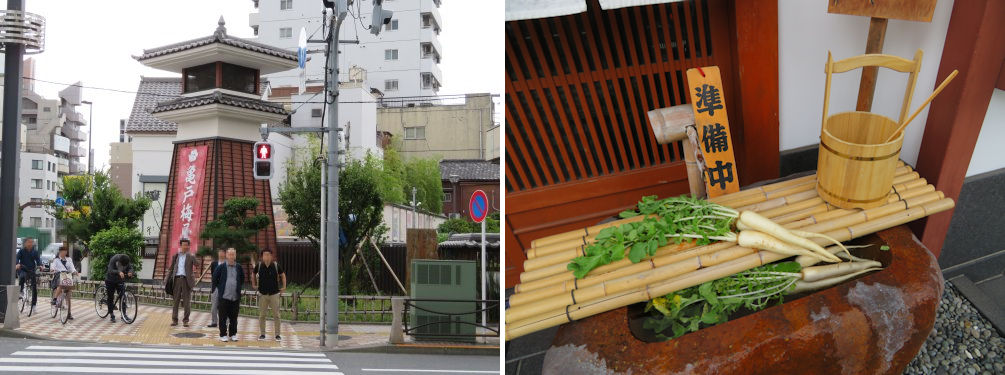
The red monument with the sign Kameido Umeyashiki (left). The gift shops and theatre are located on the right but cannot be seen in this picture. Luckily I found the Kameido radish I described above in front of a restaurant specializing in Fukagawa-meshi just behind the Umeyashiki signboard.
On another occasion, we visited Koutou Ward which lies south of Sumida Ward. The south eastern area of Koutou Ward was known as the Fukagawa district in the Edo era, and was the eastern peripheral of Edo. By the way, the area of Sumida Ward in the Edo era covered the Mukoujima district which was a pastoral area and a place for Edo folk to enjoy the countryside, as well as the Honjo district which I explored above. We took the Ooedo Line to Kiyosumi-Shirakawa Station. We started late in the morning and decided to try Fukagawameshi, a local dish. There are many restaurants that serve Fukagawameshi in the area. We searched for a restaurant in a quiet and nostalgic Showa style neighborhood just east of the station with many Buddhist temples and Fukagawa specialty shops and chose a restaurant specializing in local dishes.
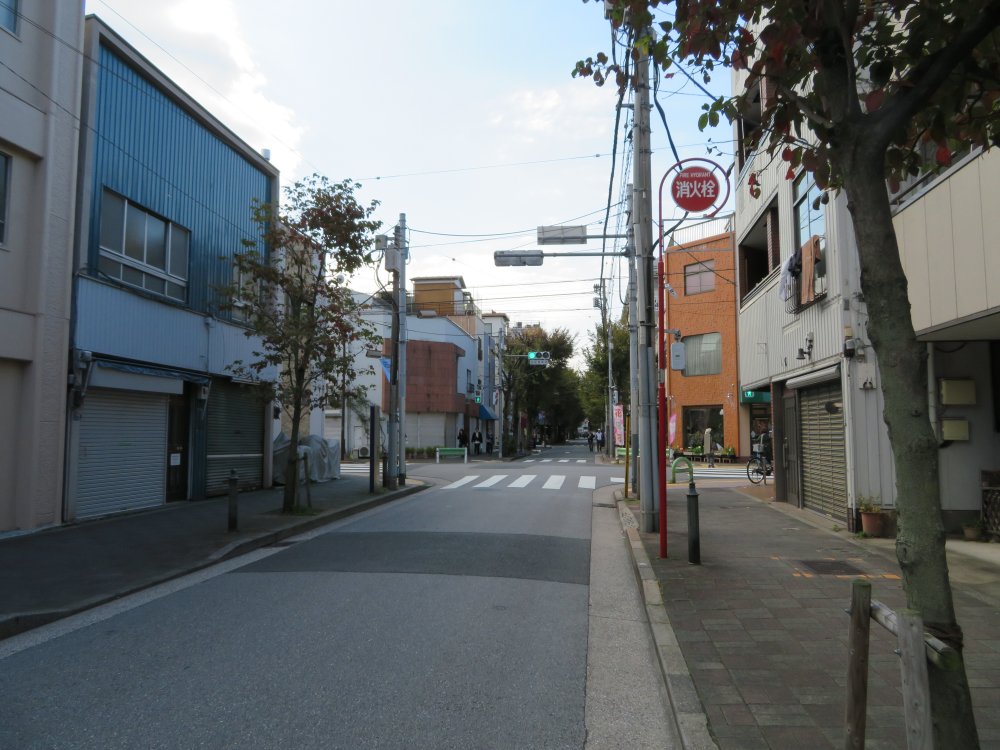
A couple of minutes' walk brings you to the Showa style quiet neighborhood along Fukagawa-shiryoukan Doori with many Buddhist temples and Fukagawa specialty shops
We had a couple of surprises. The first was the presence of many overseas tourists. It’s an area that we had never explored in detail until this occasion, and made me wonder what it was that had attracted so many visitors to the neighborhood. The second surprise was the dish itself. Of course, I knew that Fukagawameshi is a takikomi-gohan, rice and clams steamed with dashi soup stock, soy sauce and sake, but it had an enormous volume of clams, much more than I had expected. It’s a very healthy dish, light in calories, one that I would certainly recommend to try. I have subsequently learned that Fukagawameshi originated as a quick meal for fishermen (before large scale land reclamation from the Edo era, Fukagawa was on the seafront with abundant shellfish), pouring a clam and leek soup over cold steamed rice, which is also served in the restaurants. The takikomi-gohan style seems to be a later invention.
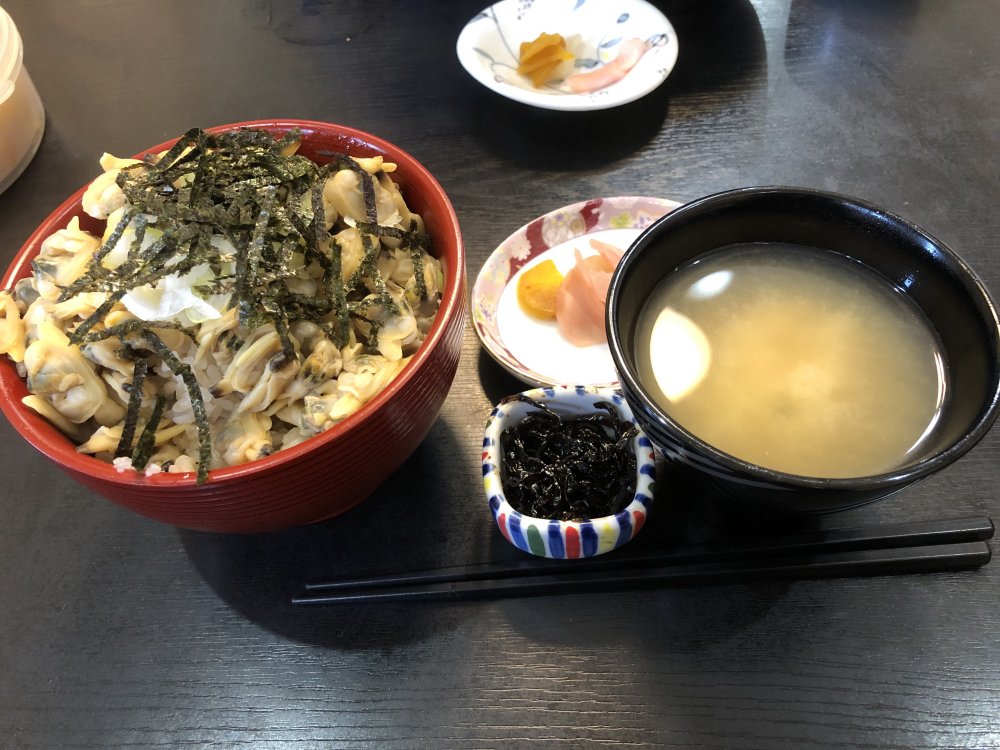
Fukagawameshi is a takikomi-gohan, rice and clams steamed with dashi soup stock, soy sauce and sake, but it had an enormous volume of clams, much more than I had expected.
We then visited the Fukagawa Edo Museum (Fukagawa-shiryoukan) opened in 1986 which displays a full-scale replica of the township of Fukagawa in the late Edo era. It was fun slipping back in time to visit the houses and shops as they were in 1840.
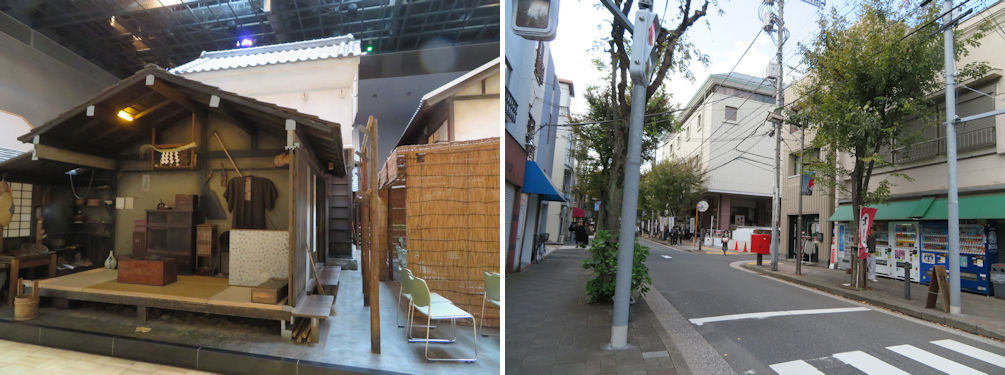
Inside the Fukagawa-shiryoukan museum (left). The museum building is on the right hand side (right).
We spent some time to explore the neighborhood. Tokyo (Edo) had two particularly devastating catastrophes. One was the Great Kantou Earthquake in 1923. The other was the Great Fire of Meireki in 1657, when 60 to 70 % of Edo was burnt to ashes. There was less damage in the Honjo and Fukagawa district. As a result of the fire, many temples and shrines as well as the lower residences of the feudal lords were relocated to either east in the Honjo and Fukagawa district or in the western suburbs, which is the reason why there are so many temples in the area and why the Fukagawa district rapidly expanded after the fire. We first visited Shusse-fudouson which worships the Buddhist deity Fudou-myouou. Legend says that Fudou-myouou appeared in the dream of a priest in Kimiidera which treasured a statue of the deity, and asked to be taken to Edo. Construction of nearby Ryouganji Temple went well and ever since the Shusse-fudouson is believed to bring promotion and success in life. It is now part of Chousen-in Buddhist Temple of the Joudo sect that relocated here after the Great Fire of Meireki.
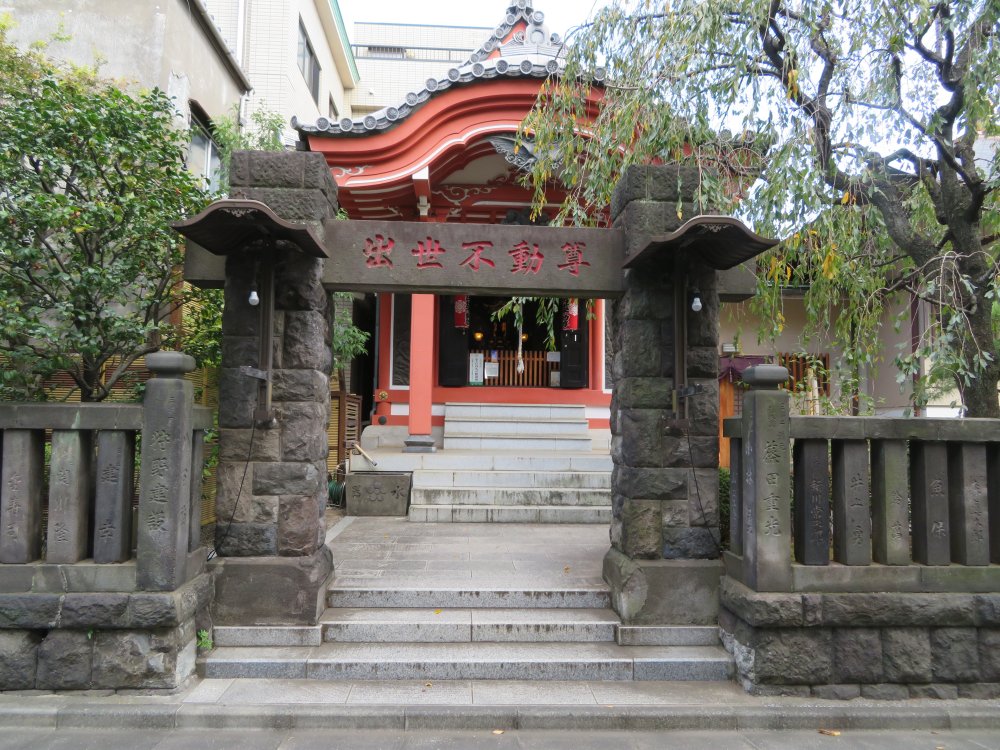
Construction of nearby Ryouganji Temple went well and ever since the Shusse-fudouson is believed to bring promotion and success in life.
Opposite Chousen-in is Reiganji Buddhist Temple of the Joudo sect. Founded in 1624, it was originally located more west in Reiganjima which is now part of Chuuou Ward, but relocated to the current site a year after the Great Fire of Meireki. The temple held a close relationship with the Tokugawa shogunate. The grave of the feudal lord of Shirakawa (Fukushima Prefecture), Sadanobu Matsudaira who initiated ascetic policies in the late 18th century is inside the temple grounds. This is from where the name of the area Kiyosumi-shirakawa derived.
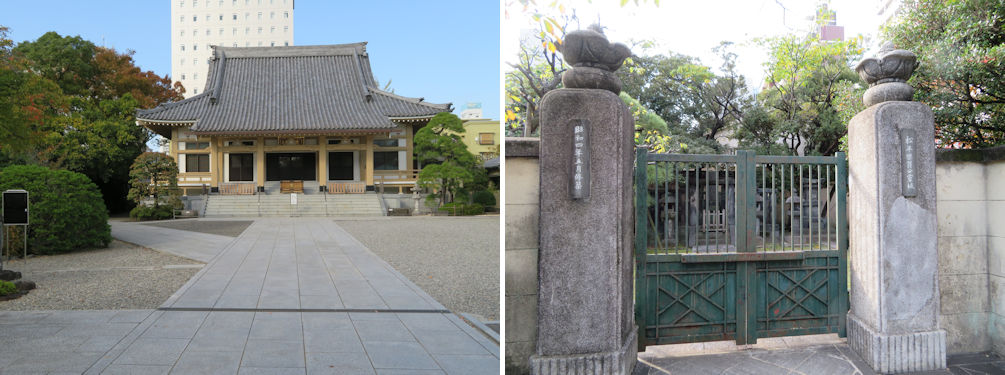
Reiganji Buddhist Temple and the temple grounds (left). The graveyard of Sadanobu Matsudaira, the feudal lord of Shirakawa (right).
We then went to visit Kiyosumi Gardens. The site of Kiyosumi Gardens was originally the shimoyashiki of the Kuze Family feudal lord of Sekijuku in Chiba Prefecture. Yataro Iwasaki, the founder of the Mitsubishi Group acquired the site, deserted and in ruins, together with adjacent land and opened a facility in 1880 to entertain Mitsubishi guests and employees. Yataro's younger brother and successor continued the landscaping of the garden by creating a mountain as well as using landscaping stones sourced from all around the country and brought the garden to its current state. The gardens suffered severe damage from the Kanto Earthquake in 1923, including the loss of both the Japanese style and Western style buildings. The following year, the Iwasaki Family donated the less affected eastern part of the gardens to Tokyo. The gardens were reinstated and opened as a municipal park since 1932. It is a most picturesque and enjoyable walk around the lake. One attraction is Mount Fuji, beautifully created with landscaping stones depicting the flow of water.

It is a most picturesque and enjoyable walk around the lake in Kiyosumi Gardens (left). One attraction is Mount Fuji, beautifully created with landscaping stones depicting the flow of water (right).